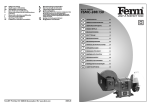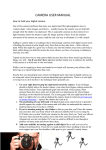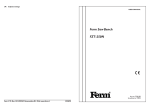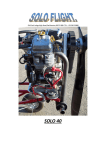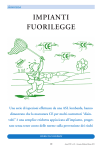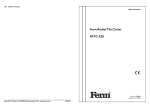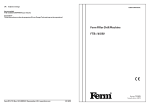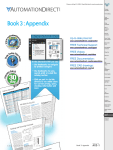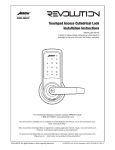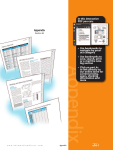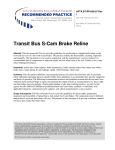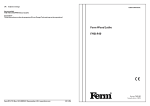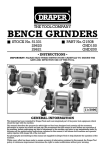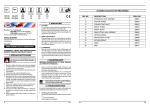Download Ferm Belt Sander / Grinder FBSM
Transcript
USER’S MANUAL Ferm Belt Sander / Grinder FBSM-150/50 Art.nr. 750350 Ferm b.v. • P.O. Box 134 • 8280 AC Genemuiden-NL • Web: www.ferm.com 0106/12 1' 230V~50Hz 240W ;; No=2950/Min 686x50mm Ø150x20mm Ø 12.7 mm Description AVAILABLE ACCESSORIES FOR FBSM-150/50 REF.NR. Fig. 1 Fig. 2 2 Fig. 3 DESCRIPTION FERM NR. 1 PROTECTION GLASS 206401 4 SUPPORT LEFT 206152 5 RUBBER FOOT 206411 6 SWITCH 206451 9 FIXING KNOB 206157 11 SPRING 206158 15 ROTATION WHEEL 206156 16 DRIVING WHEEL 206155 18 PROTECTION GLASS HOLDER 206154 Fig. 4 Ferm Ferm 7 GB BEFORE YOU OPERATE THE MACHINE: 1. Make sure the switch is “OFF” before you plug in the machine. 2. Keep the cable away from moving parts. English Product: Ferm Belt Sander / Grinder Type FBSM-150/50, Art.nr. 750350 Ferm, Genemuiden, The Netherlands Sound pressure level Lpa ! 76 dB(A) In order to prevent overheating and possible damages to the engine, use the machine for periods of 30 minutes CAREFULLY READ THE INSTRUCTIONS BEFORE YOU USE THE BELT SANDER/GRINDER! 1. ADDITIONAL SAFETY RULES BEFORE USING THE MACHINE: 1. Check the following: - Make sure that your machine is correct for your power supply. - Make sure the socket is earthed; - Make sure the cable and socket are in good condition, i.e. not frayed or damaged. 2. Do not use long extension cables. Use only earthed extension cables. 3. A grinding stone is fragile. The stone is easily damaged when being dropped, hit, etc. Always grind with the face of the grinding stone, never the sides. A cracked grinding stone must be replaced immediately. Due to the high rotational velocity the stone might disintegrate, causing accidents. 4. Always wear safety glasses when grinding. 5. Never operate the Belt Sander/Grinder without the guard in place. 6. Make sure the guard and the tool rest are properly adjusted and secured. 7. The maximum clearance between the tool rest and the grinding stone must never exceed 1-1.5 mm. 8. Use the stone only for its intended purpose, e.g. for grinding tools, never for heavy-duty construction work. Use only grinding stones that state the following: - Name of the manufacturer; - Binding material; - Dimensions; - Maximum speed. 9. Never rebore the arbor hole in the grinding stone to widen the diameter. 10. The maximum admissable rotational velocity of the grinding stone may not exceed the velocity mentioned on the stone. 11. For safe grinding it is best to bolt the machine to the bench. 6 Ferm Ferm IMMEDIATELY SWITCH OFF THE MACHINE WHEN: 1. plug and/or cable are defective or damaged; 2. the switch is defective; 3. you smell or see smoke caused by scorched insulation. 2. INSTALLATION 1. The Belt Sander/Grinder is fitted with a three-core cable and earthed plug. Therefore, always connect the plug to an earthed socket. If you have to use an extension cable, make sure it is three-core and fitted with an earthed plug and connector. 2. Do not use long extension cables. 3. The Belt Sander/Grinder has to be secured to the bench by means of bolts. The length of the bolts depends on the thickness of the bench. If your bench is made of steel, it is best to place the machine on a supporting, wooden plate to separate it from the bench, to avoid vibrations. Electrical safety Always check that the power supply corresponds to the voltage on the rating plate. Replacing cables or plugs Immediately throw away old cables or plugs when they have been replaced by new ones. It is dangerous to insert the plug of a loose cable in the wall outlet. Using extension cables • The grinding machine is fitted with a three-core cable and earthed plug. Therefore, always connect the plug to an earthed socket. If you have to use an extension cable, make sure it is three-core and fitted with an earthed plug and connector. • The minimum conductor size is 1.5 mm2. 3. DESCRIPTION THE NUMBERS BELOW REFER TO THE ILLUSTRATION ON PAGE 2: DESCRIPTION: 1. Cover glass; 2. Guard for grinding stone; 3. Grinding stone; 4. Tool rest; 5. Bottom plate; 6. ON/OFF switch; 7. Sanding belt; 8. Guard for sanding belt; 9. Knurled knob for tension roller; 10. Adjustment screw for belt position; 11. Spring; 3 12. Tool rest; 13. Motor housing; 14. Second eye for tool rest; 15. Guide roll; 16. Drive roll; 18. Cover glass holder. 4. GRINDING Grinding - Do not ‘fil up’ the stone by holding wood, lead or any other soft metal against the grinding stone; - Never press the workpiece too hard against the stone, to avoid making grooves; - Cool down the workpiece with water; - Wood chisels and such must never ‘blue’ when being ground; - Make sure the workpiece cannot slip from your fingers during grinding and get caught between the tool rest and the stone. This may cause the stone to crack, the motor to stall and the workpiece to rebound, causing injuries. MOUNTING AND ADJUSTMENT OF THE HOLDERS OF COVER GLASSES AND THE COVER GLASSES THEMSELVES. REPLACING THE GRINDING STONE - Remove the tool rest (C) (see fig. 1) by removing bolt (A) and nut (B). - Remove the three screws (A) (see Description) which fasten the guard (2) to the motor housing (13). - Remove the guard (2). - Loosen nut (A) (see fig. 2) with a spanner. NOTE: This is a left handed nut. - Remove the nut, the clamping disc (B) and the paper spacer ring (C). - Then remove the grinding stone (D). - Also remove the other clamping disc and paper spacer ring (E & F). - Clean the shaft (G) with a cloth. - Mount the new/other grinding stone. ! - Mount first the clamping disc and paper spacer ring, then the grinding stone, next the other paper spacer ring and clamping disc and the left handed nut. Retighten the nut firmly. Place the guard back and retighten the guard with screws (3x). Place the tool rest and readjust the tool rest (see Adjusting the tool rest). 5.SANDING ! - The holder of a cover glass, together with the cover glasses themselves will always be adjusted/mounted with the grinding stone being out of action and the currrent turned out. - Mount the holder of the cover glass together with the cover glass itself, by means of the screw (A). - Adjust the height of the holder of the cover glass by loosening a bit screw . The free space between the stone and the holder of the cover glass will amount to 1 - 1,5 mm. - Fasten well screw. Adjust the cover glass (see the figure above) in such a way that your face will be protected, at the utmost. Use always safety glasses at the same time you will be working with the cover glass. ADJUSTING THE TOOL REST ! - 4 Disconnect the machine and make sure the grinding stone has stopped before adjusting the tool rest. Loosen bolts (A) (see fig. 1). Move the tool rest (C) keeping a clearance of 1-1.5 mm between the tool rest and the grinding stone. Retighten bolts (A). THE CHOICE OF SANDING PAPER - With coarse sanding paper (P 50) generally most of the material can be removed, and fine sanding paper (P120) is then used for finishing. The grain of the sanding paper is mentioned on the back of the paper. - An uneven surface is first treated with coarse sanding paper and sanded until it is even. Subsequently medium-coarse sanding paper (P 80) is used to remove the scratches caused by the first type of paper used. Fine sanding paper (P 120) is used for finishing. MOUNTING OF THE BELT SANDER UNIT - Remove the drive roll. - Place the unit on the machine and fix it with the screws. - Then you place the drive roll again onto the shaft and lock it by means of the nut. - Attach the sanding paper by loosening the button in the unit (at the top left) and pushing downwards the spring. - Stretch the sanding paper as written herunder. - Close the cover with help of the three screws. MOUNTING OF THE SANDING PAPER - Loosen the knurled knob (A) (see fig. 3), but do not remove it. - Place the belt on both rolls. Use your left hand to compress spring (B) so the belt can be placed easily. ! Correct assembly of the sanding belt prevent unnecessary wear. The sanding belt has to be assembled as shown in fig 4. With your hand you can feel which part of the sanding belt is on top of the weld. Ferm - Retighten the knurled knob and turn over the sanding belt a view times with your hands. If the sanding belt runs of or runs out of line then use adjustment screw (C) to adjust the sanding belt correctly. Put the belt under tension by means of nut (D). ADJUSTING THE TOOL REST ! - Disconnect the machine and make sure the sanding belt has stopped before adjusting the tool rest. Loosen nut (E) (see fig. 3) with a spanner. Move the tool rest (F) keeping a clearance between the tool rest and the sanding belt through which the belt just runs free. Retighten nut (E). The tool rest can be assembled at two places depending on the application. 6. MALFUNCTION Below we have listed a number of possible causes and corresponding solutions in case the machine does not function as it should: 1. The tool does not work when switched on. Damaged cord and/or plug. - Check cord and/or plug. Defective switch. - Contact your local Ferm dealer to have the switch inspected and/or repaired. 2. The temperature of the electric motor exceeds 70°C. The motor is defective. - Contact your local Ferm dealer to have the tool inspected and/or repaired. 7. MAINTENANCE Faults Should a fault occur, e.g. after wear of a part, please contact your local Ferm dealer. In the back of this manual you find an exploded view showing the parts that can be ordered. ENVIRONMENT In order to prevent the machine from damage during transport, it is delivered in a sturdy packaging. Most of the packaging materials can be recycled. Take these materials to the appropriate recycling locations. Take your unwanted machines to your local Ferm-dealer. Here they will be disposed of in an environmentally safe way. GUARANTEE The guarantee conditions can be found on the separately enclosed guarantee card. ClEl■DECLARATION OF CONFORMITY (GB) We declare under our sole responsibility that this product is in conformity with the following standards or standardized documents IEC1029-2-4, EN61029-1 EN55014-1, EN61000-3-2, EN61000-3-3, EN55014-2 in accordance with the regulations: 89/392/EEC 73/23/EEC 89/336/EEC from 01-12-2000 GENEMUIDEN NL G.M. Ensing Quality department Make sure that the machine is not live when carrying out maintenance work on the motor. The Ferm machines have been designed to operate over a long period of time with a minimum of maintenance. Continuous satisfactory operation depends upon proper machine care and regular cleaning. Cleaning Regularly clean the machine housing with a soft cloth, preferably after each use. Keep the ventilation slots free from dust and dirt. If the dirt does not come off use a soft cloth moistened with soapy water. Never use solvents such as petrol, alcohol, ammonia water, etc. These solvents may damage the plastic parts. Lubrication The machine requires no additional lubrication. Ferm 5





